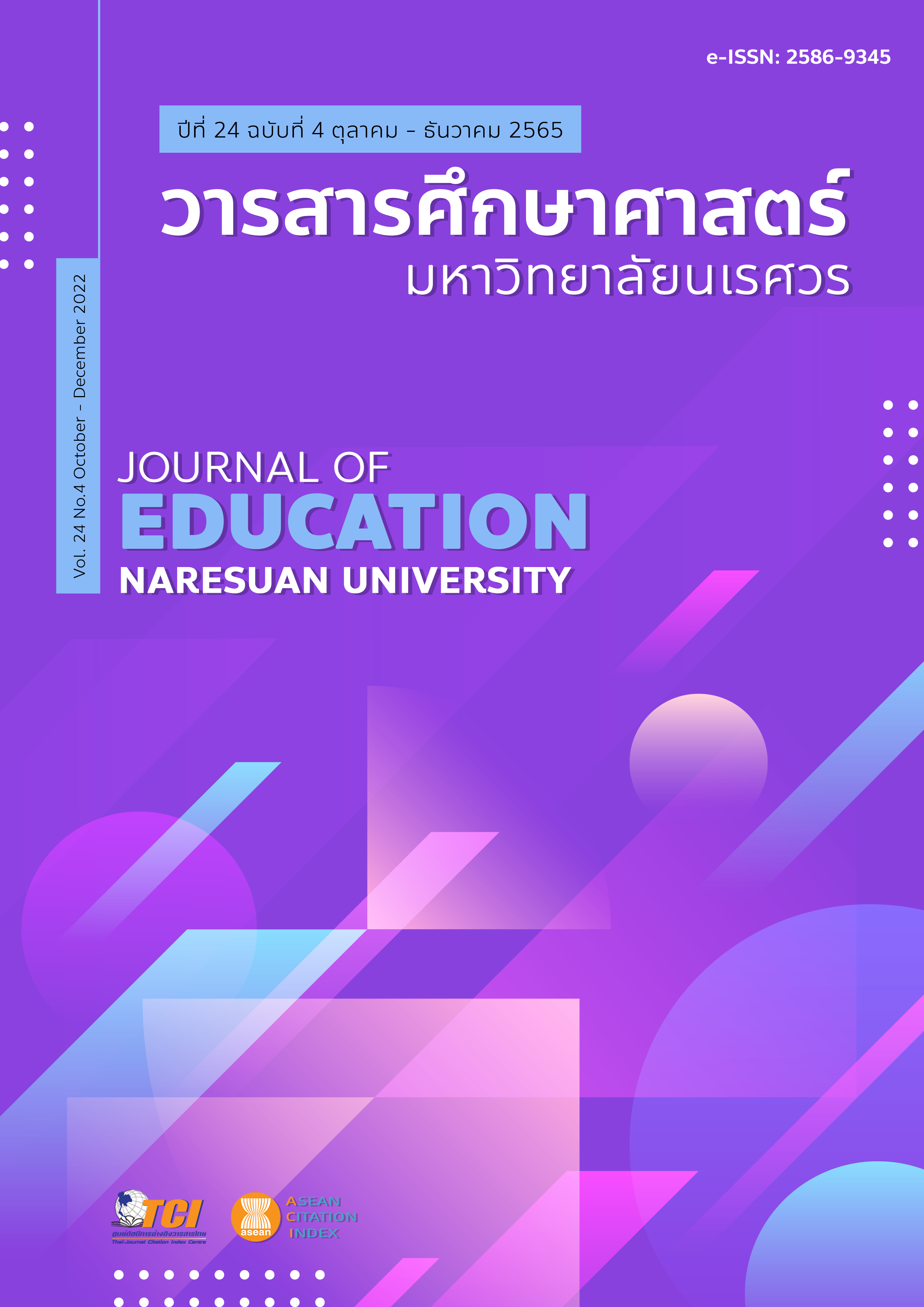DEVELOPMENT OF DIGITAL COMPETENCE OF HIGH SCHOOL STUDENTS IN THE ERA OF THAILAND 4.0 การพัฒนาสมรรถนะดิจิทัลของนักเรียนมัธยมศึกษาตอนปลายในยุคไทยแลนด์ 4.0
Main Article Content
Abstract
The purposes of this study are 1) to develop the digital competence assessment tool of high-school students; 2) to analyze the need of digital competence of high-school students; and 3) to present the encouragement methods of high-school students’ digital competence. The sample group consists of 581 Grade-12 students, Academic Year 2020, from Office of the Basic Education, via two-stage random sampling. The research tool includes the high-school 44 items of students’ digital competence assessment in which its format is 5-rating scale and dual-response format and the expert interview. The quantitative data analysis employs Indexes of Item-Objective Congruence: IOC. Construct Validity is analyzed via Exploratory Factor Analysis, Confirmatory Factor Analysis, Croncach’s Alpha Coefficient, and discrimination analysis. The needs assessment for digital competence development of high-school students applies weight needs index (WNI). The qualitative data are analyzed by content analysis. The results of the study reveal into three aspects as follows. Firstly, the indexes of item-objective congruence and construct validity of the digital competence assessment are all valid as well as the discrimination is in the good level. Secondly, the potential in communication and digital technology are considered the first priority to be developed. Finally, the encouragement methods of high-school students’ digital competence include 1) adding compulsory activities into the curriculum or extra-curriculum to improve digital competence; and 2) encouraging teachers to attend the trainings on technology media.
Article Details

This work is licensed under a Creative Commons Attribution-NonCommercial-NoDerivatives 4.0 International License.
The owner of the article does not copy or violate any of its copyright. If any copyright infringement occurs or prosecution, in any case, the Editorial Board is not involved in all the rights to the owner of the article to be performed.
References
Blyznyuk, T. (2018). Formation of teachers’ digital competence: domestic challenges and foreign experience. Journal of Vasyl Stefanyk Precarpathian National University, 5(1), 40-46. doi: 10.15330/jpnu.5.1.40-46
Calvani, A., Cartelli, A., Fini, A., & Ranieri, M. (2009). Models and instruments for assessing digital competence at school. Journal of e-learning and Knowledge Society, 4(3), 183-193.
Champathong, A. (2012). Digital sphere: The new world of digital media. Retrieved from http://www.nation.ac.th/course-works-detail.php?main=7/19/134/148&content=255 [in Thai]
Fabrigar, L. R., Wegener, D. T., MacCallum, R. C., & Strahan, E. J. (1999). Evaluating the use of exploratory factor analysis in psychological research. Psychological Methods, 4, 272-299. https://doi.org/10.1037/1082-989X.4.3.272
Gagne, P., & Hancock, G. R. (2006). Measurement model quality, sample size, and solution propriety in confirmatory factor models. Multivariate Behavioral Research, 41, 65-83.
Gallardo-Echenique, E. E., de Oliveira, J. M., Marqu, L., & Esteve-Mon, F. (2015). Digital competence in the knowledge society. Journal of Online Learning and Teaching, 11(1), 1-6.
Godhe, A. L. (2019). Digital literacies or digital competence: Conceptualizations in Nordic curricula. Media and Communication, 7(2), 25-35.
Hair, J. F., Black, W. C., Babin, B. J., Anderson, R. E., &Tatham, R. L. (2006). Multivariate data analysis (6th ed.). New Jersey: Pearson Education.
Hatlevik, O.E., Ottestad, G., & Throndsen, I. (2015). Predictors of digital competence in 7th grade: A multilevel analysis. Journal of Computer Assisted Learning, 31(3), 220-231.
Higgins, S., Xiao, Z., & Katsipataki, M. (2012). The impact of digital technology on learning: A summary for the education endowment foundation. Durham, UK: Education Endowment Foundation and Durham University.
Jongsermtrakoon, S. (2013). A group investigation learning system on open educational resources for digital literacy and awareness in information ethics of students ethics of student teachers (Master thesis). Bangkok: Chulalongkorn University. [in Thai]
Joreskog, K., & Sorbom, D. (1993). LISREL 8: Structural equation modeling with the SIMPL1S command language. Chicago: Scientific Software International.
Krumsvik, R., & Jones, L. (2013, July). Teachers’digital competence in upper secondary school. Paper session presented at the International conference at Information Communication Technologies in Education, Crete.
Li, Y., & Ranieri, M. (2010). Are ‘digital natives’ really digitally competent?-A study on Chinese teenagers. British Journal of Educational Technology, 41(6), 1029-1042.
Maderick, J. A., Zhang, S., Hartley, K., & Marchand, G (2015). Preservice teachers and self-assessing digital competence. Retrieved from http://www.google.co.th/?gws_rd=cr&ei=Wr5MWJ7WCITkvASIsYAg#
Meyers, E. M., Erickson, I., & Small, R. V. (2013). Digital literacy and informal learning environments: An introduction. Learning, Media and Technology, 38(4), 355-367.
Pisiphol, S. (2011). Creation and development of educational assessment and evaluation tools (2nd ed.). Bangkok: Faculty of Education, Chulalongkorn University. [in Thai]
Roungrong, P., Jiraworapong, B., Manyum, W., Somyaron, W., Muendej, S., & Sisurat, C. (2014). Educational technology vs Thai teachers in 21st century. Pamyapiwat Journal, 5(Special Issue), 195 - 207. [in Thai]
Saris, W. E., Satorra, A., & van der Veld, W. M. (2009). Testing structural equation models or detection of misspecifications? Structural Equation Modeling: A Multidisciplinary Journal, 16(4), 561-582.
Setkhumbong, T. (2011). Effect of e-learning using collaborative learning via social media on competency of using information and communication technology of undergraduate educational students (Master thesis). Bangkok: Silpakorn University. [in Thai]
Svensson, M., & Baelo, R. (2015). Teacher students’ perceptions of their digital competence. Procedia-Social and Behavioral Science, 180, 1527-1534.
Tangdhanakanond, K. (2014). Assessment and evaluation practical skills. Bangkok: Chulalongkorn University Press. [in Thai]
Wainwright, A. (2014). 10 Reasons today’s student need technology in the classroom. Retrieved from http://www.securedgenetworks.com/blog/10-Reasons-Today-s-StudentsNEED-Technology-in-the-Classroom
Wongragsa, K. (1997). Comparison of quality and consistency of priority setting techniques in needs assessment based on discrepancy model (Doctoral dissertation). Bangkok: Chulalongkorn University. [in Thai]


